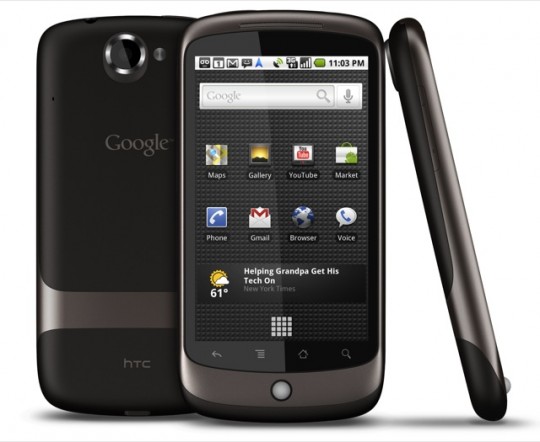
Google and HTC designed the Nexus One as a phone to set the standard for future Android devices, a bleeding edge device that was supposed to be perfection in the making.  They did an amazing job with the hardware, but the software has taken the edge off what could have been the creme de la creme of Android phones.  Plagued with issues from day one and a marketing strategy that is best left quietly alone, Nexus One was slow to take off.  Most users want to see, touch, and play with their new devices before making a purchase decision and Google’s decision not to promote the Nexus One through retail channels became their Achilles heel.  To top off the online only sales of the device, they restricted the cellular plans through its initial partner, T-Mobile, to only a single plan (and a lousy one at that).  Those were the initial marketing mistakes.
Next came the software and the problems surrounding the phone.  A list of issues were soon identified by the community and support requests and complaints starting rolling into the Google support forums.  Yes, forums!!  Users had no way to get support for the device from day one except by posting in a forum and hoping someone would reply.  This was a ludicrous way to provide support for a bleeding edge phone and eventually telephone-based support was provided, but it took a long time.
So what were the problems, what was real and what has been fixed?
3G connection errors on T-Mobile
 It appears that with the release of Android 2.2 FRF91, Google may have at last almost cured the dreaded 3G connection failures many people have been experiencing on the T-Mobile network. This issue has been driving everyone crazy, including myself, with constant 3G data connection hangups and errors. We did plenty of testing on the issue, trying many different combinations of Radio and ROMs to try and eliminate or improve the problem. We did get some better connections but never really got the issue to completely disappear. I’ve been testing the stock Android 2.2 updates and the latest alpha versions of CyanogenMOD 6, and I can say that my connection now appears to be stable. We’ve still had some reports in the forums of people still experiencing the problem, but nothing has been confirmed.
It appears that with the release of Android 2.2 FRF91, Google may have at last almost cured the dreaded 3G connection failures many people have been experiencing on the T-Mobile network. This issue has been driving everyone crazy, including myself, with constant 3G data connection hangups and errors. We did plenty of testing on the issue, trying many different combinations of Radio and ROMs to try and eliminate or improve the problem. We did get some better connections but never really got the issue to completely disappear. I’ve been testing the stock Android 2.2 updates and the latest alpha versions of CyanogenMOD 6, and I can say that my connection now appears to be stable. We’ve still had some reports in the forums of people still experiencing the problem, but nothing has been confirmed.
Touch Screen losing its sensing calibration
This has to be the most frustrating problem currently experienced on the Google Nexus One and it drives me insane. I use my Car Dock a lot and frequently have to lean over to put my Nexus One to sleep and then wake it back up again to get my touch screen calibration back in sync. When you’re at the end of a phone call and reach over to hang up the call, only to have the call muted because your phone doesn’t know where your pressing on your phone is not only frustrating, but potentially dangerous. Once this happens, you then have to fumble around on the top of the phone to hit the power button, then press it once more to wake up the device, and then swipe your finger across the screen to get past the lock screen. All this just to hang up your call. This problem has not been fixed, nor has it improved in any way at all. Come on guys, fix this issue already!
Ambient light sensor issue
When Google decided to add an ambient light sensor to the Nexus One so the screen brightness could automatically be controlled by the phone, I though this sounded like a very cool battery saving feature. Little did I know that my phone’s screen would be constantly going bright and dim so frequently that I had to turn off the auto brightness feature altogether. The settings were also so dim that I could not read my screen when it was bright out. No setting was available to control how frequently the sensor would adjust the brightness, which would have helped some, and no way was provided to calibrate the sensor to your personal taste. With the release of Android 2.2 that sensor seems to work a little better, but still not to an acceptable level for me. Why can’t we at least have a setting allowing for adjustments of the level. Just setting a low light and a high light level would be better than nothing. The perfect solution would be some form of calibration tool for you to make your adjustments. To me this feature is still a fail.
The headphones cord activates other functions
What happens when you pull out your ear phone cord from the top on your phone? Who knows is the simple answer, but for me the most common thing for my phone to do is start playing music in the background. I’ve heard of people whose phone will mute itself and other applications appearing, but can’t really confirm them. Has this been fixed with the release of Android 2.2?  Not for me, it still happens. I’m not even sure this can be fixed as it could be a hardware issue causing something to make a connection as you’re pulling out your cord. Another fail for me.
WIFI connectivity issue
There have been a couple of WiFi issues reported and they are not really related. The first problem was that the Nexus One drops its WiFi connection when it goes into sleep mode no matter what the WiFi sleep policy is set to. With the new Android 2.2 update, this appears to working correctly now. The second WiFi issue was related to dropped connections and weak signal strength. This has never been an issue for me, but people have complained of intermittent WiFi connection issues, poor signal strength and issues swapping from one network to the next. As I’ve never experienced the issue, I can’t confirm if it’s been fixed or not. If you have any more info about this problem, be sure to let us know in the comments.
Bluetooth has inadequate volume
This is definitely a big issue. I have a Plantronics headset and when I use it on other devices, the volume level is fine. When I use it on my Nexus One, I can hardly hear the person on the other end of the phone. For this reason I do not use Bluetooth on my Nexus One. This problem has not changed with the release of the Android 2.2 update. Another fail for me.
Poor speaker sound quality
As hardware manufacturers attempt to make their devices smaller and smaller, or thinner and thinner, they have to make some sacrifices. Unfortunately, the people who decide what gets sacrificed don’t seem to live in the real world. I like to use my speaker phone a lot. I like to place my phone on my desk when I’m talking to some people so my hands are free to type or do other tasks. I do this on my Nexus One, but it’s not easy to hear the conversation. Why do they add speakerphones if they are going to put in such small cheap speakers that makes people not want to use them? Because the quality of the speaker is low, they also limit the volume level you can use so you don’t damage it. Give us something realistic in the next devices. Give us something a business user can use. Give us a speaker phone that I can place in the middle of a small table so 4 people around it can have a conference call and hear what the other people are saying. Not a fail for me, but also not a pass. Needs work for sure.
So there you have a quick summary of the issues reported with the Nexus One and their current status. Â Would I still buy a Nexus One again? Yes I would. Â It’s still an awesome phone and none of the new releases from any network have made me feel like I should dump the Nexus One and purchase something else. Â Its competition is heating up and it’s slowly being removed from the phone of choice for T-Mobile and AT&T.
Did you buy a Nexus One? Did you have any issues? Would you purchase it again? Let us know your thoughts in the comments!








